The best bicycle pump for high-pressure tyres
I own an electric bicycle, for which the recommended tyre
pressure is 65psi. Purchased a couple of years ago and used
occasionally to get around locally.
Maybe I'm getting weaker in my old age, but I find it a struggle to pump the tyres to 65psi with my floor pump. I get to 60psi and decide that's good enough.
The pump has a 45mm diameter tube. I don't know anything about bicycle pumps, but I reasoned that a pump with smaller diameter tube would be easier to pump to higher pressure. Less air per plunge, but less effort. I don't know what law of physics would apply, but that reasoning did seem rational.
So, looked around, and chose one with the smallest diameter tube. Bought this off ebay, with 29mm diameter tube:
https://www.ebay.com.au/itm/223709304985
Here are the two pumps, showing clearly how much narrower is the tube of the new one:
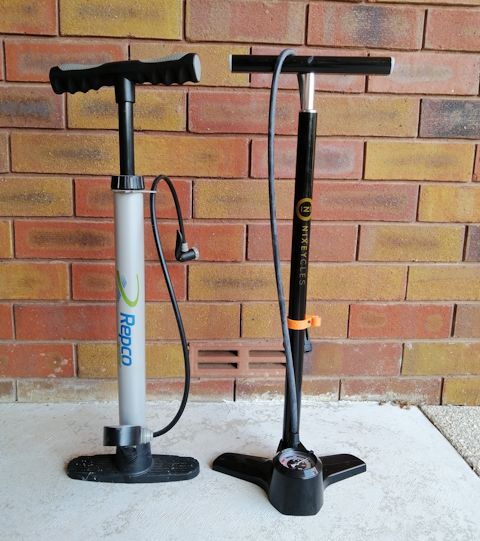
But then hit a snag; the header, the part that goes onto the tyre valve, didn't work. It refused to pump air into the tyres. The tyres have schrader valves, same as car tyres, and the header is a multi-purpose type with a single hole that is supposed to also work with schrader valves.
Lifting the lever, that clamps the header onto the valve, seems to be also blocking air flow!
Bare in mind I know nothing about tyre pumps, headers, and so on. Was I somehow putting the header incorrectly onto the valve? Tried and tried, but no joy.
Anyway, decided to buy a header that has two holes, one of them dedicated to fit a schrader valve. Bought this:
https://www.ebay.com.au/itm/144792618581
Very interesting, the lever works the opposite way to many other brands:

...and I find that to be preferable. It is an easier action to
pull the lever down toward the inlet tube.
So, put this new header onto the NIxeycle floor pump, and works great. And yes, very easy to pump to 65psi. In fact, effortlessly went to 70psi and released a bit of air.
Knowing what I now know, if I was in need of a floor pump, I
would buy one somewhat cheaper, such as this one with 32mm
diameter tube and with dual-hole header:
https://www.ebay.com.au/itm/321413387296
The pump I now have works great, no need to buy anything else.
Just posting this info in case it helps someone else who might be
wanting to buy a bicycle pump.
Tags: general
Can you guess who this young lady is?
Post deleted.
Tags: general
Happy New Year
Western Australia remains covid-free, at least we tentatively think so. Not so on the other side of Australia. Despite outbreaks in NSW, Sydney managed to put on a New Year celebration, with a smaller crowd practising social distancing.
https://www.youtube.com/watch?v=67qEUh3F334
I would like to thank everyone who tested EasyOS in 2021 and
reported issues and in some cases provided fixes. I won't post a
list of names, in case I offend someone by missing out their
name!
Tags: general
Strawberry tree and Feijoa one year on
Spring is well and truly under way, Summer approaching --
officially, summer starts here in Australia on first day of December.
One year ago, I took a photo of newly-planted Irish Strawberry tree and
Feijoa:
https://bkhome.org/news/202010/garden-before-photos.html
They were dormant all through the winter, even though winters are
very mild here. The Feijoa even lost leaves. Now though, they have
rebounded:
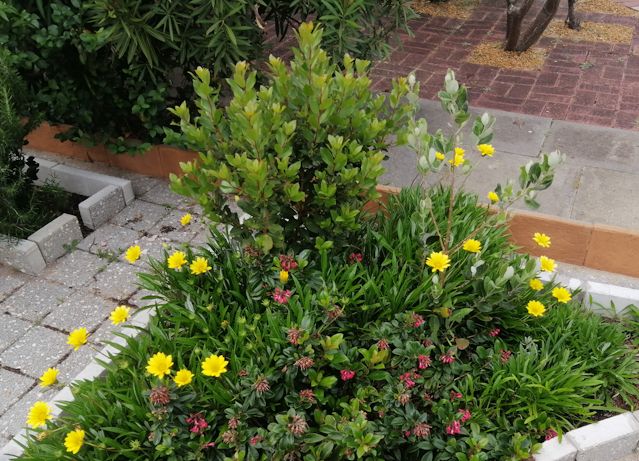
Heaps of new growth on the Irish Strawberry tree, but the Feijoa is
recovering very slowly -- I wonder if it doesn't like the soil
conditions? The ground cover plants have done
well.
Tags: general
Various helpful feedback
I would like to thank Tom and Holden for information and links
about AMD CPUs. Currently not sure whether to invest in an AMD-based PC,
as I already have a collection of PCs and laptops. OK, they are all
Intel-based, but if I buy another one, it might just sit there unused,
or alternatively, the Lenovo PC that I bought in 2020 will sit unused --
which would be a shame. So shelving that one for now.
I will still attempt to get the 5.10.x kernel to be "AMD friendly", for those who want to run EasyOS on modern AMD hardware.
David W. sent me a link to an old chap who retired from a very active job when he was 102. Have appended to this post:
https://bkhome.org/news/202101/roly-86-and-brother-88-still-powering-on.html
Rick sent me some great dog photos, on the theme that dogs are better than humans. Here is one of them:

Tags: general
Christmas greetings everyone!
Another year has rolled by. Back in 2018 I posted a photo of Santa having difficulty delivering presents in Australia:
https://bkhome.org/news/201812/xmas-and-new-year-best-wishes.html
This year, Santa is taking some time-out on the beach:

Probably a good time to reflect on the meaning of life, and not just see it as presents, drinking and making merry.
Photo courtesy of the Youth Hostels Association of Australia:
Tags: general
Simple water inlet design for a courtyard tank
I grew up in a rural location, without scheme water. There was
one huge concrete tank, that collected rain water. We had no qualms with
drinking that water, nor water from any other rainwater tanks.
These days it is deemed inadvisable to drink rainwater. Anyway, I
don't want to drink it directly, but for the kettle, for making tea and
coffee. I also boil water then cool it and keep in the fridge for
drinking. I would rather use rainwater -- suspicious about what comes
out of the tap.
I know that rainwater is said to have pollutants in it, from the
atmosphere. That would depend where you live. I live very close to the
coast, and most rain-bearing weather comes from the direction of the
ocean, so should be relatively pure. Also the surfaces on which the
water flows and is collected, are factors. The roof is clay tiles.
I bought a small tank, 720 litres, which is 190 gallons. Good
enough, got it delivered to my backyard. But then, how to connect it to
the downpipe?
Devised a simple solution, so thought to post it here, as it might be
useful for anyone else browsing the web looking for ideas how to do it.
I made it with 50mm PVC pressure pipe and fittings, here it is:

...only difference from that photo, is I stuck a small length of pipe
underneath near the 45 degree elbow, to hold it up more securely.
The top of the tank has a screw-on lid, with a leaf-strainer and mozzie-barrier inside. It was easy to cut a round hole:
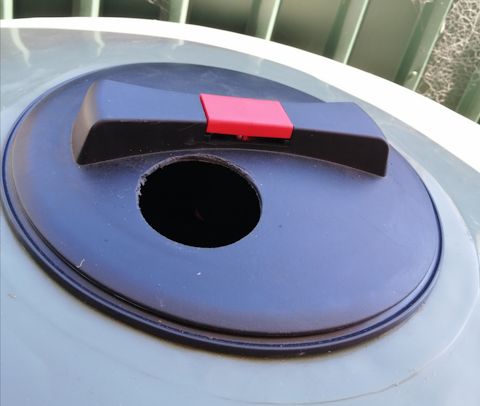
But the other end, connection to the downpipe, that is a challenge. I
wanted it to be variable, so that when the tank gets full, water can be
diverted to flow down the downpipe and not into the tank.
But firstly, cutting the round hole in the downpipe. I know it is due
to my inexperience, but when I used the hole-cutter attachment to the
electric drill, the central hole started to "wander" and the hole being
cut became erratic. So, I resorted to a nibble-tool. Have one of these
from my electronic construction days, works fine on thin galvanised
steel:
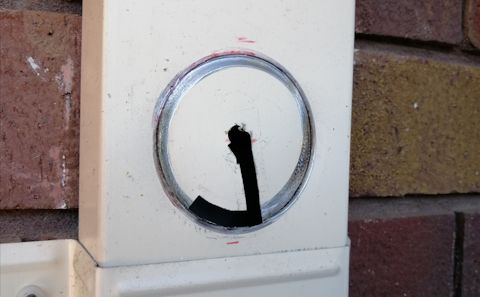
The idea I came up with, to vary water diversion, is a pipe-joiner,
that can be turned. The pipe that inserts inside the downpipe looks like
this, a cutout-section:

Then I riveted a piece of 0.5mm thick aluminium:

The idea is that the aluminium flanges can be bent inward, for
insertion of the pipe, then once inside, can reach in and push them out
again. Yeah, that worked.
Perhaps a heavy downpour will bend those flanges. I could have bought
some thicker metal, but then, so what if they bend? Even if only half
the water gets diverted into the tank, that should be enough. It is a
small tank. Perhaps then, no need for those flanges.
It came together and installed OK, but I wonder about that one-in-ten
year downpour? If the flanges are turned to vertical, thus minimising
water diversion to the tank, there will be a partial blockage in the
downpipe. So what happens if the water backs-up, right back to the
gutter?
My place has high-front type gutters, with slots cut in the front so
that water overflow will be out the front and not back into the eaves,
as this photo shows:

That is probably good enough protection. Even if water does flow back
into the eaves, it will, at worst, flow into the wall cavity. My place
is double-brick, so the inside wall won't perish. Even so, not something
that I would want to happen.
I notice that most new houses built in Perth do not have eaves, the
gutter is mounted right on the outside wall, so that extra runoff
protection is not there.
I could maybe insert something further up the downpipe, to vent-out excess water. Or maybe that is overkill.
EDIT 2020-12-24:
Here is a photo of the completed pipework, showing the small piece of pipe glued on to support the 45 degree elbow:
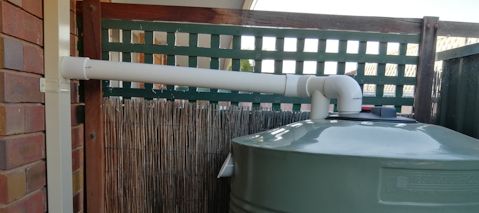
EDIT 2021-01-02:
At the downpipe-end, the pipe-joiner can be turned, so as to divert the
water either into the tank or to continue down the downpipe. I have a
tube of "heavy industrial grease", that I applied to make it easier to
turn the pipe-joiner, however, later on reconsidered -- ideally I should
find a grease that is rated for potable-water.
There are some available, and I purchased HydroSeal tap lubricant:
https://www.bunnings.com.au/hydroseal-15g-thread-lubricant-tube_p4923331

Bunnings also have another brand, Kinetic tap lubricant:
https://www.bunnings.com.au/kinetic-15g-tap-lubricant_p4920449
Tags: general
Malabar Spinach continues to flourish
I posted a snapshot of the Malabar Spinach soon after having planted it:
https://bkhome.org/news/202011/malabar-spinach-is-taking-off.html
Look at it one month later:
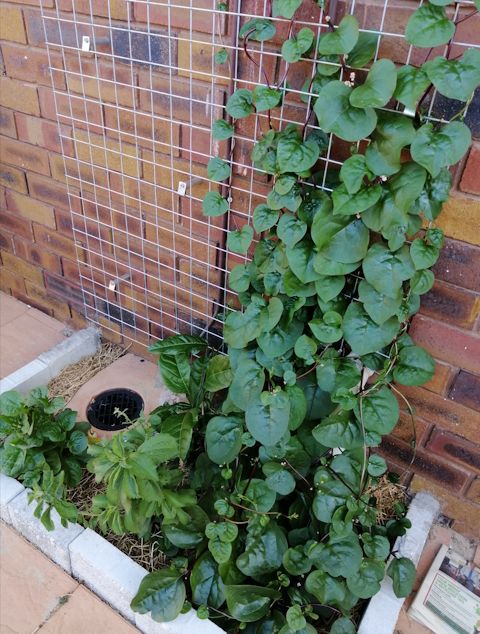
...and that's after I have pruned it a bit! It was sending tentacles
out along the ground, that I cut off, have also been cutting off leaves
for salads.
A comment about that, using the leaves in salads and cooking...
On the Internet in various places it is stated that the leaves taste
like Spinach. Hmmm, vaguely yes, but the plant is mucilaginous, so the
leaves are slightly slimy to chew. Not too slimy though, and I found
them OK in salads. Cooked, they turn to mush very quickly.
I also read on the Internet that the stems and berries are edible.
Can't say about the berries yet, but the stems are inedible -- they are
just too stringy. I cooked them in a curry, leaves and stems. Chew the
stems, and you end up with a wad of string in your mouth. Even cutting
them very short didn't help.
On the left of the photo is another that I planted recently, the
"alba" variety. The two on the right are the "rubra" (red stem) variety.
I want to find out if there is any difference in taste and texture. The
alba leaves do look slightly lighter green.
Interesting also, they are not getting any direct sunlight.
Mid-summer, the roof eave keeps them in shade all day. In winter
however, they will get direct sunlight, which might keep them going all
year round.
Tags: general

